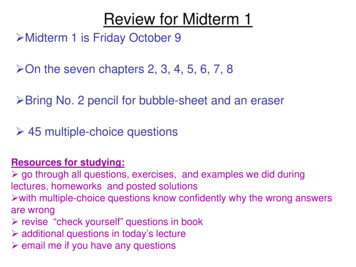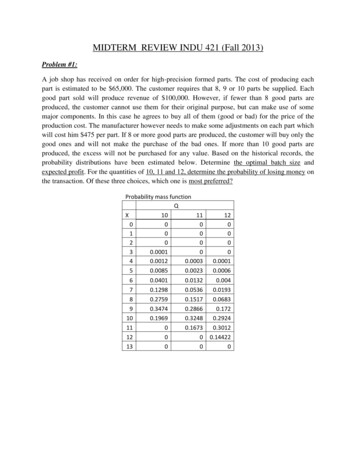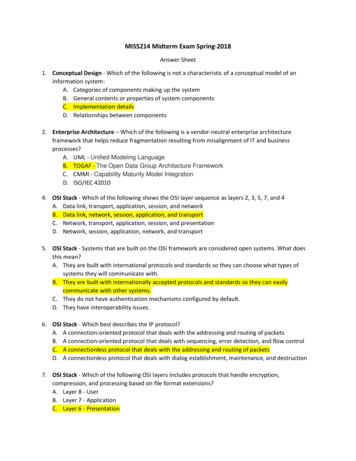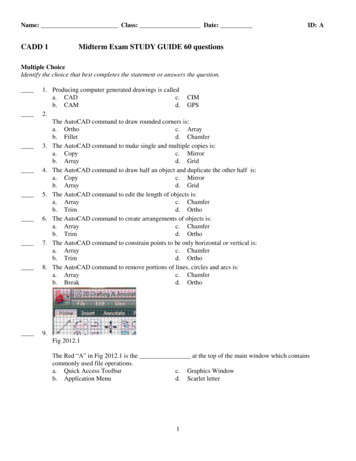
Transcription
Review for Midterm 1 Midterm 1 is Friday October 9 On the seven chapters 2, 3, 4, 5, 6, 7, 8 Bring No. 2 pencil for bubble-sheet and an eraser 45 multiple-choice questionsResources for studying: go through all questions, exercises, and examples we did duringlectures, homeworks and posted solutions with multiple-choice questions know confidently why the wrong answersare wrong revise “check yourself” questions in book additional questions in today’s lecture email me if you have any questions
Recall Chapter 2: Newton’s 1st law, inertia, forces, e.g. gravitational ( weight), supportforce, equilibrium (sum of forces 0) Chapter 3: Linear motion, speed ( distance/time), velocity ( speed withdirection), acceleration( rate of change of velocity), free-fall motion (a g,speed gains/loses g m/s every second if falling/rising) Chapter 4: N’s 2nd law, Fnet ma, weight mg, weight vs mass, friction, nonfree fall and air resistance, terminal velocity Chapter 5: N’s 3rd law, action-reaction, vectors (– only at conceptual level) Chapter 6: Momentum( mv), Impulse F t change in momentum, external vsinternal forces, momentum conservation when Fnet on system 0, collisions Chapter 7: Energy, Kinetic energy ½ m v2, Potential energy, Grav. PE mgh,Work F d, mechanical energy, change in mech. energy Work, Power Work/time, Total energy conservation, machines Chapter 8: Rotation, linear/tangential speed vs angular/rotational speed, v r ω,rotational inertia I, torque F x lever arm, angular momentum I ω, ang momconservation, CM/CG, stability
When in a subway car that suddenly stops, you lurch forward.What’s the best explanation for this?A) Because of Newton’s 1st law – you have inertia.B) Because you have no accelerationC) Because of action-reaction forces between the car and youD) Because of the support force
When in a subway car that suddenly stops, you lurch forward. What’s the best explanation forthis?A) Because of Newton’s 1st law – you have inertia.B) Because you have no accelerationC) Because of action-reaction forces between the car and youD) Because of the support forceAnswer A: Newton’s 1st law says that objects (you)tend to keep moving in a straight line; inertiaresists changes in motion
According to Newton's law of inertia, a rail road train inmotion should continue going forever even if its engine isturned off. We never observe this because railroad trainsA) move too slowly.B) must go up and down hills.C) are much too heavy.D) always have forces that oppose their motion
According to Newton's law of inertia, a rail road train in motion should continuegoing forever even if its engine is turned off. We never observe this becauserailroad trainsA) move too slowly.B) must go up and down hills.C) are much too heavy.D) always have forces that oppose their motionAnswer: DHow about if there was no friction and no air drag – thenwhat would happen once the engine is turned off?Then the train would be accelerating while the engine wason, and would stop accelerating once the engine is turnedoff – i.e would move at constant velocity.
A hockey puck is set in motion across a frozen pond. If icefriction and air resistance are neglected, the force requiredto keep the puck sliding at constant velocity isA) equal to the product of its mass times its weight.B) equal to its weight divided by its mass.C) zero.D) equal to its weight
A hockey puck is set in motion across a frozen pond. If ice friction and airresistance are neglected, the force required to keep the puck sliding atconstant velocity isA) equal to the product of its mass times its weight.B) equal to its weight divided by its mass.C) zero.D) equal to its weightAnswer: C, since no acceleration – so no net force
As you’re sitting in your chair, your weight acts as adownward force on the chair. Why then does the chair notsink into the ground?A)because of its weightB)because it feels an upward directed support forcefrom the ground it is pushing down onC)because of inertia – the resistance to changes inmotion.D)because of momentum conservation.
As you’re sitting in your chair, your weight acts as a downward force on thechair. Why then does the chair not sink into the ground?A)because of its weightB)because it feels an upward directed support force from the ground itis pushing down onC)because of inertia – the resistance to changes in motion.D)because of momentum conservation.Answer: B, the chair is in equilibrium, there iszero net force on it. The gravitational force isequal and opposite to the upward support force.
A skier covers a distance of 3 m in half a second. Whatis his average speed?A) 1.5 m/sB) 3 m/sC) 6 m/sD) 9 m/s
A skier covers a distance of 3 m in half a second. What is his averagespeed?A) 1.5 m/sB) 3 m/sC) 6 m/sD) 9 m/sC) Average speed distance/time 3m/0.5s 6 m/s
As an object freely falls downward, itsA) velocity increasesB) acceleration increases.C) both of theseD) none of these.
As an object freely falls downward, itsA) velocity increasesB) acceleration increases.C) both of theseD) none of these.A) It accelerates at either (i) a constant rate g, ifthere is negligible air resistance or (ii) graduallyless acceleration if there is air resistance.
When a rock thrown upwards falls back down and passes thesame point it was thrown from,a) its velocity is zero and its acceleration is zerob) its velocity is zero and its acceleration is about 10 meters persecond per secondc) its velocity is about 10 m/s and its acceleration is zerod) its velocity is negative of the initial velocity it was thrown up withand its acceleration is about 10 meters per second per second.
When a rock thrown upwards falls back down and passes the same point it was thrownfrom,a) its velocity is zero and its acceleration is zerob) its velocity is zero and its acceleration is about 10 meters per second per secondc) its velocity is about 10 m/s and its acceleration is zerod) its velocity is negative of the initial velocity it was thrown up with and its accelerationis about 10 meters per second per second.Answer d) Note, acc. in free-fall (on earth) is alwaysg 10 m/s2
Half a second after starting from rest, a free-falling objectwill have a speed of abouta) 10 m/sb) 20 m/sc) 5 m/sd) 0e) None of these
Half a second after starting from rest, a free-falling object will have a speedof abouta) 10 m/sb) 20 m/sc) 5 m/sd) 0e) None of theseAnswer c) In free fall, object gains about 10m/s everysecond. So, in half a second, gain 5 m/s.What is it’s acceleration at that time?a g 10 m/s2 downwards, alwaysfor free-fallWhat if the free-falling object is moving upward at a speed of 20 m/s.What is its speed half a second later?15 m/s since it loses 10m/s everysecond
Two balls are thrown from the same point high on a cliff. Oneis thrown upwards and the other is merely dropped fromrest. Neglecting air resistance, which has the higheracceleration?A) The ball thrown upwardsB) The ball dropped from restC) It depends on how fast the thrown ball was thrownD) It’s the same for eachE) None of these
Two balls are thrown from the same point high on a cliff. One is thrown upwardsand the other is merely dropped from rest. Neglecting air resistance, whichhas the higher acceleration?A) The ball thrown upwardsB) The ball dropped from restC) It depends on how fast the thrown ball was thrownD) It’s the same for eachE) None of theseAnswer: D, acceleration g downwards
If a projectile is fired straight up at a speed of 10 m/s,the total time to return to its starting position is aboutA) 2 seconds.B) 10 seconds.C) 20 seconds.D) 1 second.E) not enough information to estimate
If a projectile is fired straight up at a speed of 10 m/s, the total time toreturn to its starting position is aboutA) 2 seconds.B) 10 seconds.C) 20 seconds.D) 1 second.E) not enough information to estimateAnswer: AEach second it loses about 10m/s so after 1s, ithas zero velocity, i.e. is turning around. Then itgains 10m/s as it falls, so after another second (atotal of 2 s) it has -10m/s i.e. same initial speed atwhich it began, hence returned to the same point.So, if you’re told an object thrown directly upwards from the ground spends 2sin the air before returning to ground ( it’s “hang-time”), then you know thespeed it was initially kicked up with was 10 m/s.
A rock weighs 30 N on Earth. A second rock weighs 30 N onthe moon. Which of the two rocks has the greater mass?A) the one on the moonB) the one on EarthC) They have the same mass.D) not enough information to say
A rock weighs 30 N on Earth. A second rock weighs 30 N on the moon. Which ofthe two rocks has the greater mass?A) the one on the moonB) the one on EarthC) They have the same mass.D) not enough information to sayA) Because weight mg, and g leaston moon, so m must be bigger to getthe same weight of 30N
A 20-kg girl and her 40-kg big brother are each sitting on asled, waiting to be pushed across the snow. To providethem with equal horizontal acceleration, we would have topush withA)B)C)D)E)equal forcestwice as much force on the boytwice as much force on the girlfour times as much force on the boynone of these
A 20-kg girl and her 40-kg big brother are each sitting on a sled, waiting to bepushed across the snow. To provide them with equal horizontal acceleration,we would have to push withA)B)C)D)E)equal forcestwice as much force on the boytwice as much force on the girlfour times as much force on the boynone of theseAnswer: BSince a Fnet/m, an object with twice the massrequires twice the force in order to experience thesame acceleration.
A girl pulls on a 10-kg wagon with a constanthorizontal force of 20 N. If there are no otherhorizontal forces, what is the wagon's accelerationin meters per second per second?A) 2.0B) 0.5C) 20D) 200E) None of the above
A girl pulls on a 10-kg wagon with a constant horizontal force of 20 N. Ifthere are no other horizontal forces, what is the wagon'sacceleration in meters per second per second?A) 2.0B) 0.5C) 20D) 200E) None of the aboveAnswer: A, since a F/m 20/10 2 m/s2What if there was a friction force of 5 N?Then a F/m (20-5)/10 1.5 m/s2
What horizontally-applied force will accelerate a 200-kgbox at 1 m/s2 across a floor against a friction force of400N?a) 200 Nb) 400 Nc) 600 Nd) 2400 Ne) None of these
What horizontally-applied force will accelerate a 200-kg box at 1 m/s2 across afloor against a friction force of 400N?a) 200 Nb) 400 Nc) 600 Nd) 2400 Ne) None of theseC) Fnet Fapplied – friction maSo, Fapplied ma friction 200 400 600 N
Several balls of different masses are dropped from the 15th floor ofthe North Building. Neglecting air resistance, the quantity that hasthe same value for each ballA)B)C)D)E)energyaccelerationmomentumforce exerted upon striking the groundAll of the above
Several balls of different masses are dropped from the 15th floor ofthe North Building. Neglecting air resistance, the quantity that hasthe same value for each ballA)B)C)D)E)energyaccelerationmomentumforce exerted upon striking the groundAll of the aboveAnswer: BIn free-fall all objects fall at the same rate, a g. The velocity will alsobe the same for all balls, but the momentum will not, since momentum mv and mass is different for each ball. Also their energies aredifferent because their mass is different, and the force exerted uponstriking the ground will also be different because of this.
A large person and a small person wish to parachute atequal terminal velocities. The larger person will have toa) Jump first from the planeb) Pull upward on the supporting strands to decrease thedownward net forcec) Jump lightlyd) Get a larger parachutee) Get a smaller parachute
A large person and a small person wish to parachute at equal terminalvelocities. The larger person will have toa) Jump first from the planeb) Pull upward on the supporting strands to decrease the downward netforcec) Jump lightlyd) Get a larger parachutee) Get a smaller parachuted) If he does nothing, the larger person would acceleratefor longer and have a larger terminal velocity. So he needsto do something to decrease this and effectively increaseair resistance – i.e. get larger parachute.
Consider a large cannonball and a small ping-pongball, each being dropped from the same point on atree. Which experiences the greater air resistanceforce as it falls?A) The ping-pong ballB) The cannonballC)The same on each
Consider a large cannonball and a small ping-pong ball, each beingdropped from the same point on a tree. Which experiences the greaterair resistance force as it falls?A) The ping-pong ballB) The cannonballC) The same on eachAnswer: BAir resistance force is greater for greater speeds and forgreater sizes. Cannonball has greater size, and also hasgreater speed (Remember to distinguish btn force andits effect -- acceleration)See also detailed explanation in Lecture 3 questions aboutelephant vs feather, and iron ball vs wooden ball
A player catches a ball. Consider the action force to be theimpact of the ball against the player’s glove. Thereaction to this force isa) player’s grip on the gloveb) Force the glove exerts on the ballc) Friction of ground against player’s shoesd) Muscular effort in the player’s armse) None of these
A player catches a ball. Consider the action force to be the impact of the ballagainst the player’s glove. The reaction to this force isa) player’s grip on the gloveb) Force the glove exerts on the ballc) Friction of ground against player’s shoesd) Muscular effort in the player’s armse) None of theseAnswer: b)Force of object 1 on object 2 -(Force of object 2 on object 1) – thesetwo forces make action-reaction pair
As a 1-kg ball falls, the action force is the 10-N pull of theEarth’s mass on the ball. The reaction force isA) air resistance acting against the ball, but less than 10NB) acceleration of the ballC) pull of the ball’s mass on the earth, but less than 10-ND) pull of the ball’s mass on the earth, equal to 10-NE) None of these
As a 1-kg ball falls, the action force is the 10-N pull of the Earth’s mass on theball. The reaction force isA) air resistance acting against the ball, but less than 10NB) acceleration of the ballC) pull of the ball’s mass on the earth, but less than 10-ND) pull of the ball’s mass on the earth, equal to 10-NE) None of theseAnswer: DEvery force can be thought of as part of an actionreaction pair: Force that object I exerts on object II isequal and opposite to the force that II exerts on I.So here the reaction force is the gravitational pull onEarth exerted by the ball, and it is 10-N upwards.
A wooden sphere and an iron sphere of the same size andshape are dropped simultaneously from a table and happen toreach the ground at the same time. The iron sphere has agreaterA) momentum.B) acceleration.C) speed.D) all of theseE) none of these
A wooden sphere and an iron sphere of the same size andshape are dropped simultaneously from a table and happen toreach the ground at the same time. The iron sphere has agreaterA) momentum.B) acceleration.C) speed.D) all of theseE) none of theseAnswer: AIf they’re dropped at the same time and reach the ground at thesame time, then they must have had the same speed andacceleration (air resistance was negligible or similar on bothduring the relatively short fall). The iron ball will have moremomentum as its mass is larger.
An automobile and a baby carriage traveling at thesame speed collide head-on. The impact force isA) greater on the baby carriage.B) greater on the automobile.C) the same for both.
An automobile and a baby carriage traveling at the same speed collidehead-on. The impact force isA) greater on the baby carriage.B) greater on the automobile.C) the same for both.c) The same for both – action/reaction(Similarly, same momentum change for both)
Padded dashboards in cars are safer in an accidentthan nonpadded ones because an occupant hittingthe dash hasA) increased momentum.B) increased time of impact.C) decreased impulse.D) decreased time of impact.
Padded dashboards in cars are safer in an accident than nonpadded onesbecause an occupant hitting the dash hasA) increased momentum.B) increased time of impact.C) decreased impulse.D) decreased time of impact.Answer: B, same change of momentum tofinal zero, but done over a longer timemeans the force is less.
When two objects collide,A) their total momentum is always conservedB) their total energy is always conservedC) their total energy and momentum are sometimesconservedD) their total energy and momentum are always conservedunless heat is generatedE) more than one of the above is trueF) none of the above is true
When two objects collide,A) their total momentum is always conservedB) their total energy is always conservedC) their total energy and momentum are sometimesconservedD) their total energy and momentum are always conservedunless heat is generatedE) more than one of the above is trueF) none of the above is trueAnswer: AEnergy is conserved only sometimes, when the collision is elastic.
A 2-kg chunk of putty moving at 2 m/s collides withand sticks to a 6-kg bowling ball initially at rest.The bowling ball and putty then move with aspeed ofa) 0b) 0.5 m/sc) 1 m/sd) 2 m/se) More than 2 m/s
A 2-kg chunk of putty moving at 2 m/s collides with and sticks to a 6kg bowling ball initially at rest. The bowling ball and putty thenmove with a speed ofa)b)c)d)e)00.5 m/s1 m/s2 m/sMore than 2 m/sb) Momentum before momentum after(2kg)(2m/s) 0 ((2 6)kg) vSo v 4/8 0.5 m/s
Newton’s Third Law is most closely related toA)B)C)D)momentum conservationangular momentum conservationenergy conservationinertial resistance to changes in motion
Newton’s Third Law is most closely related toA)B)C)D)momentum conservationangular momentum conservationenergy conservationinertial resistance to changes in motionAnswer: AMomentum conservation follows directly from Newton’s third lawas explained directly in class lectures.
Two cars of mass m are move at equal speeds v towardseach other. What is their combined momentum afterthey meet?a) 0b) mvc) 2mvd) None of these
Two cars of mass m are move at equal speeds v towards each other. What istheir combined momentum after they meet?a) 0b) mvc) 2mvd) None of theseAnswer a) Net momentum after net mom. before 0Assuming they don’t rebound from each other, how much of thekinetic energy was transformed to heat and sound?All of it! i.e. mv2And if they do bounce back, is it possible for them each to bounce backwith a greater speed than their speed of approach? Why or why not?No, because it would violate energy conservation,Eg if they bounced back each with speed 2v, then although final momentum 2mv –2mv 0 initial momentum (so momentum conserved), the initial kinetic energy mv2is smaller than the final kinetic energy ½ m (2v)2 2mv2.
An astronaut, floating alone in outer space, throws a baseball.If the ball floats away at a speed of 20 meters per second,the astronaut willA) move in the opposite direction, but at a lower speed.B) move in the opposite direction but at a higher speed.C) move in the opposite direction at a speed of 20 m/s.D) not move as stated in any of the above choices.
An astronaut, floating alone in outer space, throws a baseball.If the ball floats away at a speed of 20 meters per second,the astronaut willA) move in the opposite direction, but at a lower speed.B) move in the opposite direction but at a higher speed.C) move in the opposite direction at a speed of 20 m/s.D) not move as stated in any of the above choices.Answer: AMomentum is conserved so the momentum gained bythe ball is equal and opposite to the momentumgained by the astronaut. Since the astronaut has alarger mass than the ball, and momentum mv,his/her speed will be less than that of the ball’s.
If you throw a ball horizontally while standing on rollerskates, you roll backward with a momentum thatmatches that of the ball. Will you roll backward if yougo through the motions of throwing the ball butinstead hold on to it?A) YesB) No
If you throw a ball horizontally while standing on roller skates, you rollbackward with a momentum that matches that of the ball. Will you rollbackward if you go through the motions of throwing the ball but insteadhold on to it?A) YesB) NoAnswer: BIf no momentum is imparted to the ball, no oppositely directedmomentum will be imparted to the thrower. Going through the motions ofthrowing has no net effect. If at the beginning of the throw you beginrecoiling backward, at the end of the throw when you stop the motion ofyour arm and hold onto the ball, you stop moving too. Your position maychange a little, but you end up at rest. No momentum given to the ballmeans no recoil momentum gained by you.
A ball rolling down an incline has its minimum kinetic energyA) half way down the incline.B) at the end the incline.C) at the top of the incline.D) impossible to predict without knowing the ball's massE) impossible to predict without knowing the size of the ball
A ball rolling down an incline has its minimum kinetic energyA) half way down the incline.B) at the end the incline.C) at the top of the incline.D) impossible to predict without knowing the ball's massE) impossible to predict without knowing the size of the ballAnswer: C) At top, it has max potential energy, andmin kinetic energy. PE gets transformed to KE as itrolls, and speed increases.Another Question:Is there a point at which the ball rolling down theincline has equal potential and kinetic energy? If so,where is it? Answer: Half-way down, since then the ball is at half itsinitial height so PE mgh is half as much, and by energyconservation, this half has gone into KE.
A 1000-kg car is hoisted up twice as high as a 2000-kgcar is. Raising the more massive car requiresA) Less workB) Twice as much workC)Four times as much workD)As much workE) More than four times as much work
A 1000-kg car is hoisted up twice as high as a 2000-kg car is. Raising themore massive car requiresA)B)C)D)E)Less workTwice as much workFour times as much workAs much workMore than four times as much workAnswer: D. Work done gain in potential energy mgh.So twice the mass with half the height, means the samepotential energy.
A car moving at 100 km/hr skids 40 m with lockedbrakes. How far will the car skid with lockedbrakes if it were traveling at 50 km/hr?A) 5 mB) 10 mC)20 mD)40 mE) 80 mF) 160 m
A car moving at 100 km/hr skids 40 m with locked brakes. How far willthe car skid with locked brakes if it were traveling at 50 km/hr?A) 5 mB) 10 mC) 20 mD) 40 mE) 80 mF) 160 mB)At 50 km/h it has half the speed so 1/4 times the KE.Work done by brakes F.d KE, so need 1/4 times thedistance, i.e. 1/4 x 40 m 10 m.
A feather and a coin will have equal accelerations whenfalling in a vacuum becauseA) the force of gravity is the same for each in a vacuum.B) the force of gravity does not act in a vacuum.C) the ratio of each object's weight to its mass is the same.D) their velocities are the same.E) none of these.
A feather and a coin will have equal accelerations when falling in a vacuumbecauseA) the force of gravity is the same for each in a vacuum.B) the force of gravity does not act in a vacuum.C) the ratio of each object's weight to its mass is the same.D) their velocities are the same.E) none of these.Answer: C)This ratio is g acceleration due to gravity
If several balls of different masses are thrown across a fieldwith the same initial velocity, neglecting air resistance, thequantity that will have the same value for each ball isA) momentumB) energyC) accelerationD) impulse imparted upon striking the groundE) all of the above
If several balls of different masses are thrown across a fieldwith the same initial velocity, neglecting air resistance, thequantity that will have the same value for each ball isA) momentumB) energyC) accelerationD) impulse imparted upon striking the groundE) all of the aboveAnswer: CThe acceleration is always just that due to gravity, 9.8 m/s2, samefor all objects when neglecting air resistance. Even though thevelocity will be the same, the momentum will be different foreach ball if the masses are different, and likewise the energy andimpulse.
Which has greater kinetic energy, a person running at 4 mi/hor a dog of half the mass running at 8 mi/h?A) the dogB) the personC) Both have the same kinetic energy.D) More information is needed about the distance traveled.
Which has greater kinetic energy, a person running at 4 mi/h or a dog of half themass running at 8 mi/h?A) the dogB) the personC) Both have the same kinetic energy.D) More information is needed about the distance traveled.A) KE ½ mv2, so for dog, mass halved but vdoubled means KE is doubled.
Suppose that your two friends are planning the design of aroller coaster where the cars initially start from rest.Friend “A” says that each summit must be lower than theprevious one. Friend “B” disagrees and says that as longas the first one is the highest, then it doesn’t matter whatheight the others are. Who do you agree with?A) AB) BC)Neither of them – it doesn’t matter which summit is thehighest
Suppose that your two friends are planning the design of a roller coaster wherethe cars initially start from rest. Friend “A” says that each summit must belower than the previous one. Friend “B” disagrees and says that as long asthe first one is the highest, then it doesn’t matter what height the others are.Who do you agree with?A) AB) BC) Neither of them – it doesn’t matter which summit is the highestAnswer: BThe height of the initial summit determines the total energy of the car atany point along the coaster. The car could just as well encounter a lowsummit before or after a higher one, so long as the higher one isenough lower than the initial summit to compensate for energydissipation by friction.
If you haul up your bag of groceries up the stairs twice as fast as yourfriend hauls his equally-heavy bag of groceries, thenA)B)C)D)You have expended more energy in moving the bag upYou have exerted greater net impulseYou have exerted greater net force on the bagYou have exerted more power.
If you haul up your bag of groceries up the stairs twice as fast as yourfriend hauls his equally-heavy bag of groceries, thenA)B)C)D)You have expended more energy in moving the bag up.You have exerted greater net impulseYou have exerted greater net force on the bagYou have exerted more power.Answer: DPower Workdone/time. The work done on the bag is the change inits gravitational potential energy, mgh, which is the same for eachbag, so there is the same work done, so you have expended sametotal energy in moving the bag up. (thinking of any sound, heatgenerated equally). But you do it in less time, so the power you exertis greater.
A huge rotating cloud of particles in space gravitatetogether to form an increasingly dense ball. As itshrinks in size the cloudA) rotates slower.B) rotates faster.C) rotates at the same speed.D) cannot rotate.
A huge rotating cloud of particles in space gravitate together to form anincreasingly dense ball. As it shrinks in size the cloudA) rotates slower.B) rotates faster.C) rotates at the same speed.D) cannot rotate.B) Angular momentum is conserved, so ifshrinks so that moment of inertia I decreases,then angular speed ω must increase
Consider a string with several rocks tied along its lengthat equally spaced intervals. You whirl the stringoverhead so that the rocks follow circular paths.Compared to a rock in the middle of the string, a rock atthe outer end movesA) half as fast.B) twice as fast.C) at the same linear speed.
Consider a string with several rocks tied along its length at equally spacedintervals. You whirl the string overhead so that the rocks follow circularpaths. Compared to a rock in the middle of the string, a rock at the outerend movesA) half as fast.B) twice as fast.C) at the same linear speed.Answer: BThey have the same angular (rotational) speed,but the one twice as far from the center has twiceas large linear (tangential) speed.
A small boy places a rock under the middle of a longwood plank, sits near one end and his heavier mothersits near the opposite end. To balance each other,A) both should move closer to the ends of the plank.B) the boy should move closer to his mother.C) the mother should move further away from the boy.D) both should move closer to the middle of the plank.E) None of the above choices would work.
A small boy places a rock under the middle of a long wood plank, sitsnear one end and his heavier mother sits near the opposite end. Tobalance each other,A) both should move closer to the ends of the plank.B) the boy should move closer to his mother.C) the mother should move further away from the boy.D) both should move closer to the middle of the plank.E) None of the above choices would work.Answer: EThe mother has greater weight, so to balance the torque F x leverarm of that of the boy’s, the lever arm to the mothermust be smaller, i.e. mother must move in closer (or boymove out further)
The centers of gravity of thethree trucks parked on thehill are shown by the x’s.Which truck(s) will tip over?A) 1B) 2C) 3D) 1 and 2E) 2 and 3F) 1 and 3G)None of themH)All of them
The centers of gravity of the three trucksparked on the hill are shown by thex’s.Which truck(s) will tip over?A) 1B) 2C) 3D) 1 and 2Answer: AE) 2 and 3F) 1 and 3G) None of themH) All of themAs indicated. the center of gravityof Truck 1 is not above its supportbase, while that of trucks 2 and 3are above theirs.
A solid ball and a hula-hoop, initially at rest, start rollingdown a hill together. Which reaches the bottom first?
A girl pulls on a 10-kg wagon with a constant horizontal force of 20 N. If there are no other horizontal forces, what is the wagon's acceleration in meters per second per s











